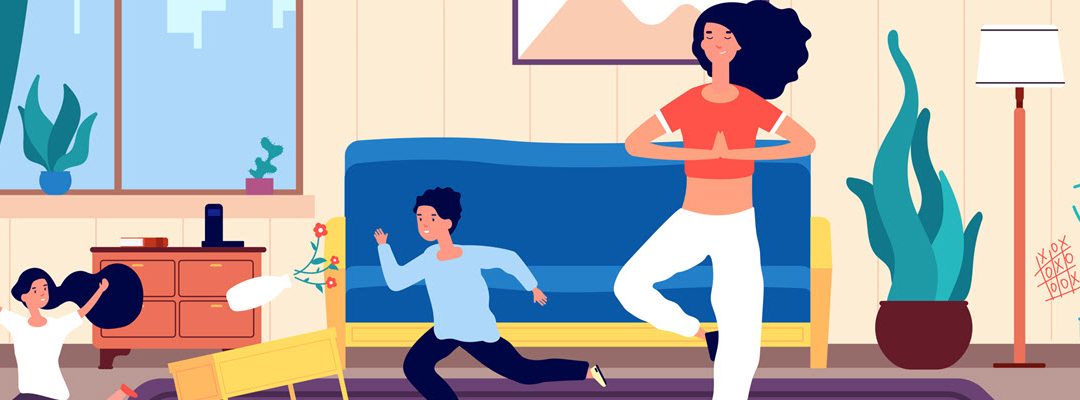Anxiety pushes us outside of our current comfort zone so that we can strengthen our self-esteem and experience internal growth.
Anxiety is best described as fears and worries that we experience when we make a decision or when we are considering future outcomes. In his book, The Untethered Soul, Michael Singer described anxiety as the negative “incessant voice” that you hear in your head.
According to the National Institute of Mental Health (NIMH), occasional anxiety is a normal and expected part of life. But, what does that mean? The best way to explain this is through a visual. Imagine working out for the first time. You want to build muscle and improve your strength, so you start by lifting 5 lbs dumbbells. In order to build muscle you must first create stress on your current muscles, this will allow your body to adapt and build more muscles.
In life, we experience smalls amount of anxiety…
… or stress so that we can learn to adapt and become stronger, or what I like to say, better version of ourselves.
However, if you over exert yourself in a workout by lifting more than what you can physically handle, you may risk more damage than good. This is the same with our anxiety. If we experience more anxiety/ stress than we are able to handle at one time, we risk developing an anxiety disorder.
The Diagnostic Statistical Manual describes anxiety disorder different from developmentally normative fear or anxiety by being excessive or persisting beyond developmentally appropriate periods. Anxiety disorders typically last at least 6 months.
Now you may ask, “Is it possible to have anxiety for more than six months and it not be a disorder?”
 Yes, it is possible. The most notable indication that you, or someone close to you, is struggling with an anxiety disorder is if their anxiety causes distress or impairment in social, school, work or other important areas of life. In situations where you may believe that you or a loved one may be struggling with an anxiety disorder is would be beneficial to speak with a mental health professional to understand your anxiety further and learn ways to cope with these thoughts so that they are not negatively impacting your life.
Yes, it is possible. The most notable indication that you, or someone close to you, is struggling with an anxiety disorder is if their anxiety causes distress or impairment in social, school, work or other important areas of life. In situations where you may believe that you or a loved one may be struggling with an anxiety disorder is would be beneficial to speak with a mental health professional to understand your anxiety further and learn ways to cope with these thoughts so that they are not negatively impacting your life.
Are there any benefits to your Anxiety?
 Earlier, I mentioned that anxiety is an expected and normal part of life. Despite the bad reputation that anxiety receives from society, there are some benefits to experiencing anxiety, or listening to that negative, incessant voice in your head.
Earlier, I mentioned that anxiety is an expected and normal part of life. Despite the bad reputation that anxiety receives from society, there are some benefits to experiencing anxiety, or listening to that negative, incessant voice in your head.
Despite the bad reputation that anxiety receives, there are some benefits to experiencing anxiety:
1. Anxiety allows us to reflect on our current situations and decisions and to make more suitable choices. Think: a warning sign or built-in alarm system
2. Anxiety pushes us outside of our current comfort zone so that we can strengthen our self-esteem and experience internal growth (I will discuss more about our comfort zones in a future post).
3. Anxiety can motivate us to not procrastinate and thus, lowering our levels of emotional exhaustion.
4. Anxiety can allow us to take careful consideration of multiple possible outcomes of our choices.
Holistic Tips to Manage Your Anxiety
Sometimes that incessant voice can be overwhelming despite our attempts to befriend it.
 It may seem like every time you try to accomplish a task or try a new activity that incessant voice seems to always have something negative to say. Whether it is your looks, your goals, something new you are trying to do, or even just getting through the day, that incessant voice appears to be an internal barrier. In those situations, there are ways to manage that internal voice. These are the common techniques I recommend to my clients.
It may seem like every time you try to accomplish a task or try a new activity that incessant voice seems to always have something negative to say. Whether it is your looks, your goals, something new you are trying to do, or even just getting through the day, that incessant voice appears to be an internal barrier. In those situations, there are ways to manage that internal voice. These are the common techniques I recommend to my clients.
Anxiety can be an internal warning sign or built-in alarm system.
1. Cartoon Character: This technique was adapted by Francine Shapiro, founder of EMDR (Eye Movement Desensitization Reprocessing). Imagine a silly character from your childhood, such as Donald Duck or Mickey Mouse (Since I live in the Orlando area, I prefer to use Mickey Mouse as an example). Every time you hear your incessant voice, imagine the voice sounding like Mickey Mouse. It’s hard to take anything serious when it sounds like a silly cartoon character.
2. Challenging negative thoughts with positive ones. You hear it all the time, “Your thoughts have power” but do they really? Yes, this is true! If you have a negative thought (“I cannot do that”) you will create a negative emotion (anxiety, fear, worry), as a result a negative behavior (isolation, avoidance, procrastination) will follow, and that behavior will strengthen your negative thought and the cycle continues. By changing your negative thought with an “opposite” thought you are able to change your behavior. For example if you say out loud, “I can do that” you will experience a different emotion and behavior than if you would think, “I cannot do that” (I will discuss more about challenging negative thoughts in a future post).
3. Swirl: Imagine the image that brings you anxiety, now place that image in a bucket of paint and swirl it up.
4. Exercise: Take a brisk walk or run while you are thinking about the image or anxious thought. Studies indicate that bilateral stimulation (like alternating steps when you walk or run) induces reprocessing of thoughts that lessens the intensity of your emotion.
5. Meditation is a great tool to use to help manage anxiety. You don’t have to be a Yogi or Guru to experience the benefits of meditation. There are numerous of guided meditations free on YouTube, and a lot of free apps that guides any beginner into a 3-5 minute meditation session.
By changing your negative thought with an “opposite” thought you are able to change your behavior.
6. Mindfulness techniques are another great tool similar to meditation. A few popular mindfulness techniques to use are Progressive Muscle Relaxation, Grounded Meditation, and Diaphragmatic breathing. Again, you can find a lot of great guided videos on YouTube.
7. Baths: Warm soothing baths are great to help relax the mind, body, and soul. Certain herbs/ oils can also help induce a soothing reaction such as lavender, chamomile, eucalyptus oil, and lemongrass oil are just a few. Experiment and see which one works best for you.
8. Coloring: There are a lot of great Mandala coloring books found in many local art stores. If you are tight with money, there are free, printable pages you can find online. These are a great way to melt away your anxiety and move into a soothing, calming, and clearer mentality, while relaxing your body. Coloring isn’t your thing? Pottery, painting, drawing, sculpting, or any other arts and crafts activity can be just as effective.
References:
Anxiety Disorders. (2018, July). Retrieved July 27, 2019, from https://www.nimh.nih.gov/health/topics/anxiety-disorders/index.shtml
Ciccarelli, S. K., & White, J. N. (2014). Psychology: DSM 5. Boston: Pearson.
Shapiro, F. (2014). Getting past your past: Take control of your life with self-help techniques from EMDR therapy. Rodale.
Singer, M. A. (2013). The untethered soul: The journey beyond yourself. New Harbinger Publications.



